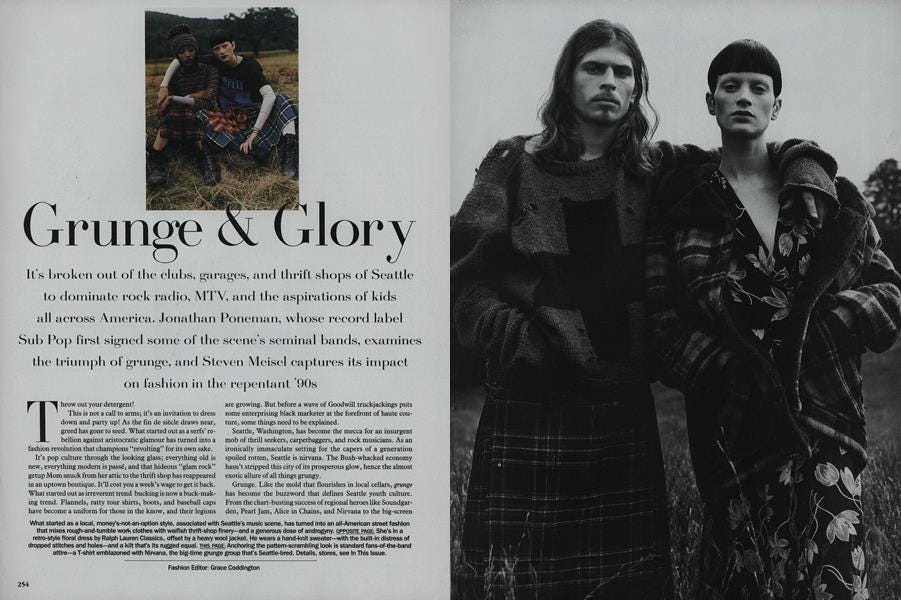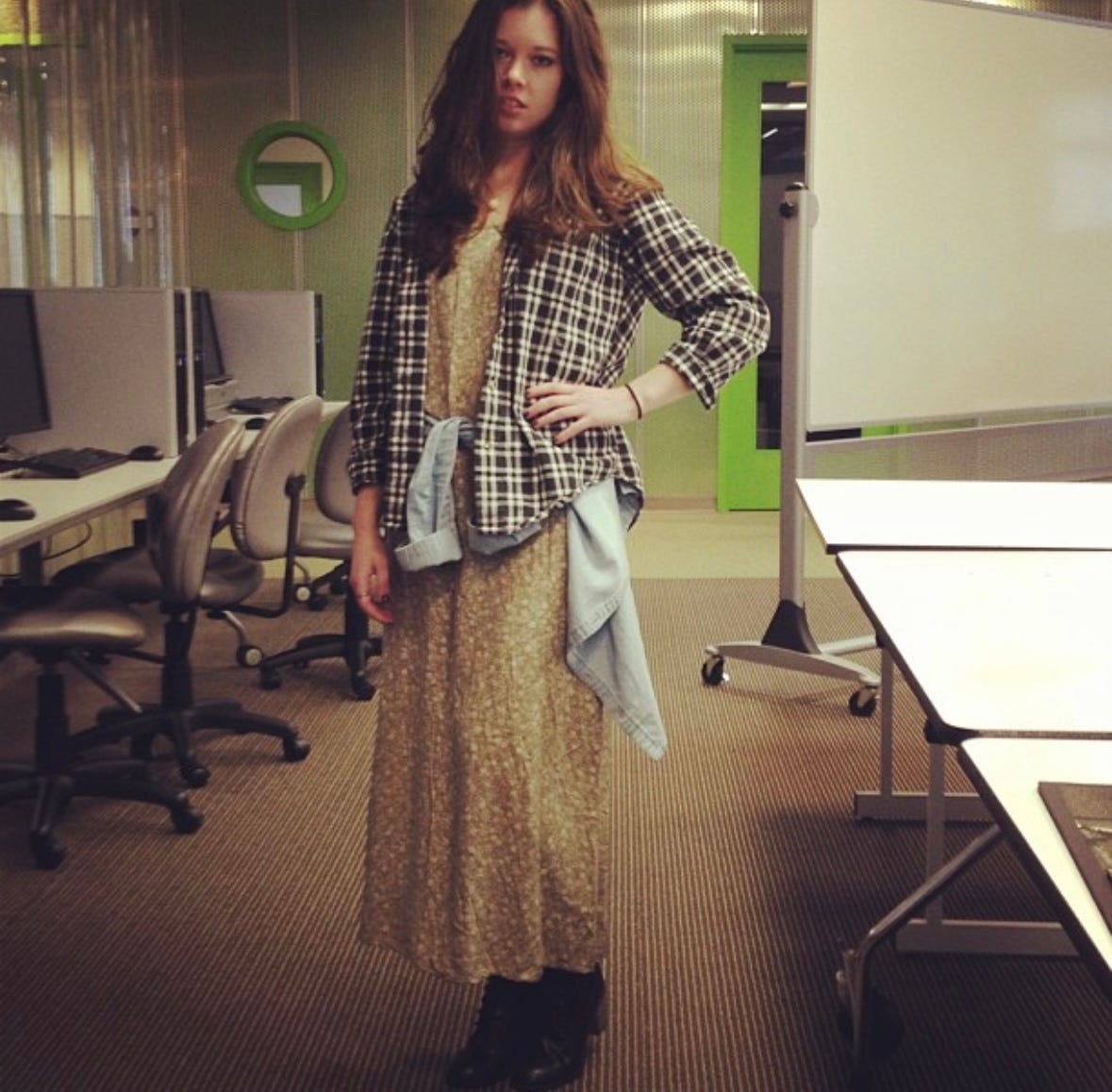13 years ago I was sitting in a Fashion Theory classroom at SCAD Atlanta, learning about fashion subcultures.
Each of us had been assigned a subcultural group to research and present on. To my own delight, I was assigned grunge (a foreshadowing of sorts, but I’m sure my professor at the time thought it would be an interesting dichotomy to my own self-presenting polished, Jcrew preppy style.) Others were diving into groups as broad as Lolitas, Punk, and earlier subcultures like Dandys.
Throughout history, style or dress was a by-product of a shared culture. Fashion has historically been a signifier of someone’s socioeconomic status, beliefs, country of origin, and even hobbies or activities. If you played tennis on the weekends, you had an outfit for tennis on the weekends. Everyone else who also played tennis on the weekends had a different, but similar coded style. And that hobby and its uniform had an influence on the rest of your wardrobe.
Music subcultures have had some of the strongest fashion codes. Punk, Grunge, Emo, Blues, Rock, and early Hip-Hop: these immediately bring to mind not just the music genres themselves, but also an entire “look” and lifestyle associated with it. It isn’t just the fashion.
Grunge is one of the most interesting to dive into because of its recorded rise to the mainstream. In the early 90’s, bands like Nirvana and Soundgarden were making music in their garages in Seattle, Washington. It sounded raw, distorted, and angsty. The fashion looked the same. The movement started spreading to the rest of the U.S. as the music did, and seeing new cultural icons like Kurt Cobain on MTV wearing a ratty sweater, distressed jeans, and converse created a completely new look. Designers like Marc Jacobs, a few years in at Perry Ellis, took note of what was happening and sent “grunge” down the runway in the fall of 1992, a year after “Smells like Teen Spirit” debuted on MTV. A few months later, much to Anna Wintour’s disdain (she hated grunge, we have Grace Coddington’s persistence to thank for the storied feature), Grunge & Glory had a 12 page spread in Vogue Magazine. Using not just Marc’s pieces, but she took some of the most preppy and polished designers like Ralph Lauren and made them grunge.
What happened with Grunge is something that has always happened with fashion subcultures. They start organically as a counter movement to whatever is happening on the macro level culturally. (Grunge specifically was in direct response to the over commercialization of the 80’s. It was polished, label forward, and slick. Grunge, both the fashion, the music, and the attitude, was the opposite of all of it.)
Then, a movement or a subculture is picked up by mainstream media as a novelty or a story, and they’re either adopted by some degree to the masses or they’re seen as too out there and kept to their minority origins.
If this sounds familiar, it is. It’s the trend cycle. Or a version of it. A trendsetter starts something (let’s use Kurt Cobain for lack of a better reference), an early adopter sees it and resonates (early grunge listeners/followers in Seattle), it’s introduced to the mainstream (Marc Jacobs for Perry Ellis/ Grunge Glory in Vogue) and then it cycles through the decline, becoming obsolete and everyone moves on to the next thing. But wait….
Kurt Cobain and Courtney Love didn’t stop being “grunge” when Vogue ran their editorial, or when every kid on the street was wearing a flannel overshirt and Doc Martens with their Ralph Lauren dresses. I’m sure they were annoyed by it, but they didn’t cut their hair and become preppy overnight as a response to it. We can all think of that friend from high school or college that’s still wearing their band tees, slip on vans, and skinny jeans. I know a lot of them. They’re musicians. I bet if you think back, anyone who’s still wearing something that’s quote “out of style” likely has a much deeper association with the subculture that birthed the trend in the first place. Even if they’ve evolved on the surface (and ditched the skinnies), there are likely traces still. A full sleeve of american traditional tattoos. Their sneaker of choice either a converse or a van, even if they’re wearing something more comfortable and classic to work during the week. (Ok, now I’m just talking about my own husband).
In 2012 when I started studying fashion, Myspace was a thing of the past, Facebook was still the place to upload dozens of unedited photos from the weekend, and Instagram was really starting to take shape as the go-to app for creativity and self-expression. Fashion blogs were just starting to become mainstream, and Instagram quickly became the go-to platform for sharing the newest form of creative self-expression: OOTDs. Fast forward a few years and the influencer economy/culture was in full swing, and the pressure to keep up became more ever present than ever. But influencers aren’t really to blame for killing our style….
Social media itself is. We’re becoming more isolated than ever because of technology, and for a lot of us, social media IS our hobby. Tiktok users alone spend an average of an hour daily on the app, and screen time in general is over 7 hours per day for most Americans now. Less and less of us are doing things like playing tennis on the weekends, starting a pop punk band with our friends just for fun, or hanging out at poetry clubs. We spend most of that time online now. For the rare instance that we do any of those things, it’s the exception not the rule, and social media is still an active part of every piece of it. We take photos just to post them on our feeds as proof we did a physical activity, or we start a Tiktok account so we have somewhere to post our songs or our poetry in order for anyone to ever hear them. If you disagree with this and you ARE someone who has a rich life of activities and interests with other groups of people who also enjoy those same things, know that you are living life to the fullest, but I promise you there are double the amount of people that are spending the majority of their leisure time every week scrolling or watching a screen of some size, alone. Not all of us, but a lot of us, are watching other people participate in those activities. And we’re watching a wide variety of them, not just the ones we’re actually drawn to or might participate in ourselves.
Our fashion subcultures now almost exclusively live inside of our phones. People we find on the internet that we’ve never met in real life but that we resonate with in some way. It’s the community of sustainability/second hand focused fashion. Or a community of like sized people who love or are interested in fashion. Or a group of influencers we love to follow because they are also moms but have an entirely different lifestyle than we have and we find it interesting.
I would argue that, as much as I love fashion, it was never meant to be the sole common denominator in our communities and what binds us together. It was always supposed to be an expression of that community (or communities) bound by something greater than just the expression itself. In a world that’s made it incredibly easy to take a pinterest board and a credit card and just become someone else entirely, it’s just as easy to cycle through and discard everything to move onto the next “it” aesthetic because we aren’t tied in any way emotionally or physically to the clothes that we wear.
You can become a coastal grandmother having never actually been to a beach. You can dress the part of “quiet luxury” even though you’ve never lived an Upper East Side life. As I am sitting here writing this, I literally got an email from Pinterest titled “Ashlyn, this could be your vibe”. Social media gave us the keys and insights to all of these lifestyles, their subsequent uniforms, and the links to shop it all. Before social (Facebook, a blog, Instagram, Tiktok), you might not have known these ever existed. Or you did, but you only saw an insight into them a few times a year (hello Grunge & Glory December 1992 Vogue issue). It’s a problem that plagues our society in more ways than this- we now know about, and seemingly HAVE, infinite options (and at every price point). Hence our need to continually cycle through trends and styles at a rapidly increasing pace, constantly searching for the thing that will feel like us.

So what do we do about it? Go sign up for horseback riding, a crochet club, and start a band all at once and see what comes of it? Well, yes if you have the time (and money)! I for one have been on a quest to find a “hobby” for a year now. I know it probably holds some piece of unlock for me in creating an identity outside of what I do for work, which if I’m honest consumes about 90% of my time (I’m sure some of you, startups not included can still relate). But I think the actual key is just slowing down. Taking stock of the things that have *actually* inspired you in your life- whether they’re offline or online- before just consuming more and more in the search for it. Because the reality is, we are living in a digital world now. We may always find our communities online in the future because of lack of access to our own kind of people, geographically or otherwise. In a lot of ways, social media has brought us closer together with the kinds of people we always wanted to surround ourselves with. But in other ways, it’s caused chaos and a lack of understanding around who we really are, or who we actually want to be….beyond just the next click.
This is exactly the kind of thing we’re chewing on DAILY inside Fashivly right now. How do we facilitate an experience and a process that does bring you closer to a true outward expression of your lived experiences- IE what’s beyond the Pinterest board of outfits as a starting point. No polished answers here yet. Just thoughts.
Drop yours below!








thank God someone finally gets it!! i work with teens and they don’t know ANYTHING ab the history/references of the clothes they are wearing and it makes me Feel Crazy
This post blew my mind tonight so THANK YOU. I’m sitting here thinking about how prep style stemmed from a prep life, grunge from the music, etc. And I’m asking myself what touchstone exists for my own style. I’d argue motherhood has shaped my style significantly (the need for practicality) BUT I also dress up more than the moms around me. So it’s probably an amalgamation of my motherhood identity + online style presence + those interests that have no basis (like seeing a vintage item that just speaks to you). I’ll be thinking on this for a while.